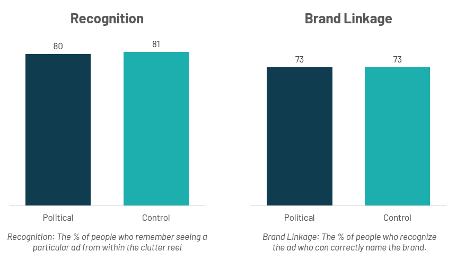How brands (and their ads) can survive election season
In election years, the media landscape experiences a significant influx of funding, as political campaigns vie for attention and influence. According to Ad Impact’s 2023/2024 Political Ad Spending Projections Report, 2024 political ad spend is expected to grow 13% compared to 2020, to a staggering $10.2 billion. This intense competition and the potentially divisive nature of political advertising present unique challenges for brands striving to get their messages across in between.
One of these challenges is the change in tone that accompanies political advertising. Compared to the typically upbeat and positive tone of brand advertising, political ads often adopt a more serious, and sometimes negative, tone. This stark contrast can create a jarring backdrop against which brands have to try and make their messages heard and remembered.
Another hurdle is the sheer volume of new competition. Brands are no longer just competing against each other for consumers' attention. They now also must contend with well-funded political campaigns that are equally eager to capture the public's attention. The cluttered media environment can make it difficult for brands to cut through the noise.
Lastly, the increased polarization in society introduces another layer of potential complexity. In certain situations, brands must think about how their messaging could land with different groups of consumers.
Despite these challenges, there is good news. Three in four consumers (78%), claim that political advertisements do not influence their perception of other ads, according to Ipsos data. Some say that they find brand advertising to be a refreshing break from the often-negative political ads.
We decided to objectively assess the accuracy of this consumer perception using Ipsos’ Creative Spark solution. Ipsos selected 10 brand ads across a variety of categories and tested them in two environments: one featuring standard non-political ads (control) and another composed of political ads. Subsequent questions were asked to understand ads' breakthrough ability and how political ads impact consumers' perception of these ads.
The data suggests that the barrage of political advertising does not significantly detract from the ability of brand ads to get noticed, be remembered and to be accurately attributed to the brand.

Source: Ads tested with Ipsos’ Creative Spark solution, N=1,600, U.S., Men & Women
Interestingly, some ads we assessed performed better in the context of political advertising than in the average regular ad break. The style of the ad can play a role in its performance. Ads that adopt a positive, uplifting, and emotional tone can stand out amid the negativity of political ads. These ads can offer a welcome contrast, potentially resulting in enhanced performance.
Furthermore, some consumers are increasingly aligning their purchasing decisions with their values. This trend offers an opportunity for brands to resonate with consumers on a deeper level. However, brands need to tread carefully when taking a stance on issues. Any missteps can lead to potential unwanted associations and may even prompt consumer boycotts.
In the face of these challenges, brands need to be steadfast. If they decide to take a stance on an issue, they should remain consistent in their position, even if it provokes some backlash. Brands that stay the course, while ensuring their campaigns are rooted in solid, strategic foundations, can weather the storm.

Source: Ipsos Meta-Analysis of 5,153 ads from 2015-2020
The rise of connected TV advertising offers additional opportunities for brands during election years. With its geo-targetability and advanced data integration features, connected TV advertising allows for more effective targeting. This can alleviate brand safety concerns as political ads become more efficient, serving only specific potential voters.
While election years present a unique set of challenges for brands in the advertising space, they also offer opportunities for brands to stand out, resonate with consumers on a deeper level, and strengthen their brand identity. Brands that traverse these challenges with strategic foresight, a clear understanding of their audience, and an unwavering commitment to their values can succeed in this dynamic environment.
Navigating the nuances of advertising during election years can be challenging, but with tools like Creative Spark, brands can leverage data to make more informed decisions. Reach out to Ipsos to learn more about Creative Spark.


![[WEBINAR] The Super Bowl’s Best Ads of 2025](/sites/default/files/styles/list_item_image/public/ct/event/2025-01/linkedin_1.png?itok=LXfnrrAL)
![[WEBINAR] What the Future: Creativity](/sites/default/files/styles/list_item_image/public/ct/event/2024-06/feature.png?itok=h0nPE0pn)